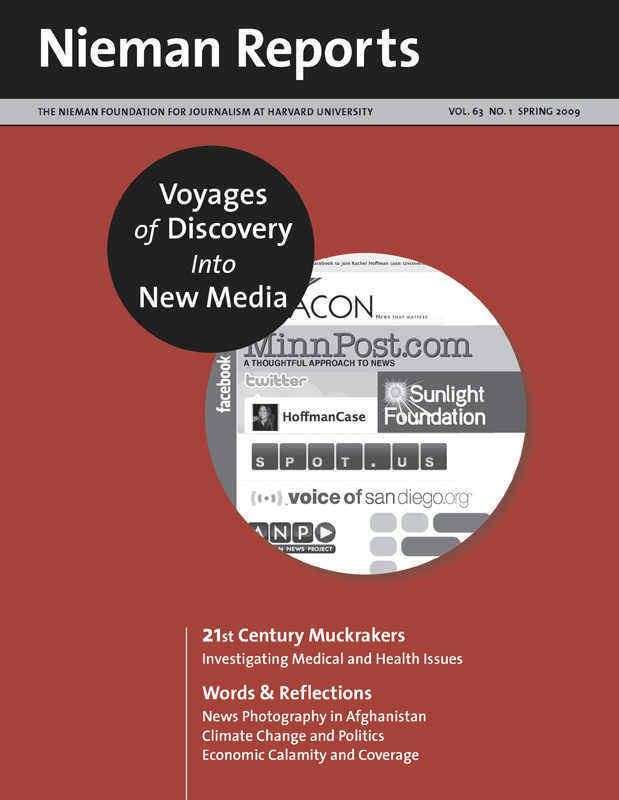Crisis has its way of focusing the mind. And so it has—many minds. In February, one metro newspaper ended its 150-year publishing history, while others are so financially strapped as to be teetering on the cliff’s edge; the fate of still others resides in bankruptcy court. In such times of despair, ideas about how to pay for journalism are blossoming. Debate about their utility is also well underway.
Since late in 2008, when Nieman Reports invited journalists at U.S. digital news sites and some at newspapers doing multimedia storytelling to share their experiences, the search for viable solutions has intensified. These practitioners’ voyages of discovery now offer guidance. Their experiences become pieces to fit into our jigsaw puzzle of possibilities—a puzzle that most experts believe still lacks a completed border of viability.
Questions abound: Is news reporting—content to digital practitioners—a commodity for which people will pay? If they will, then how much and by what means? Micropayments deducted for a click? Or a Web banking system with the coin-rattling name of Kachingle? Subscriptions? Would payment by users and online ads be enough to support the work of journalists? (Hint: One analyst calculated that “publishers recaptured just 1.7 cents in online ad revenue for every $1 of print advertising that they lost in the first nine months of 2008,” according to Alan Mutter, who discusses such issues on his blog “Reflections of a Newsosaur.”) Stop the presses—and thereby eliminate print production and delivery costs—but can the digital product support those who create the content? Should for-profit news companies be transformed into nonprofit organizations? Will philanthropists and foundations be willing to fund news sites on more than a temporary basis? How is the labor-intensive watchdog role of journalists to be assured in such unsettled times?
While discussions go on, digital news enterprises gain respect (and receive resumés) from their journalistic brethren. Investigative reporters live by the axiom “follow the money,” so as we follow the awards that journalists hand out, we discover that digital news is being welcomed at the table. The Pulitzer Prizes now allow submissions “entirely of online content” in all 14 prizewinning categories. At the first Shorty Awards honoring Twitter microbloggers, Knight Foundation President Alberto Ibargüen, a financial backer, sent a Tweet: “@shortyaward winners, how will you use Twitter to innovate?” And at the Pew Research Center’s Project for Excellence in Journalism, a New Media Index tracks what bloggers follow and the content of the top linked-to stories is compared with what the mainstream news media covered.
Digital media have arrived. Will journalism find a way to remain?
Since late in 2008, when Nieman Reports invited journalists at U.S. digital news sites and some at newspapers doing multimedia storytelling to share their experiences, the search for viable solutions has intensified. These practitioners’ voyages of discovery now offer guidance. Their experiences become pieces to fit into our jigsaw puzzle of possibilities—a puzzle that most experts believe still lacks a completed border of viability.
Questions abound: Is news reporting—content to digital practitioners—a commodity for which people will pay? If they will, then how much and by what means? Micropayments deducted for a click? Or a Web banking system with the coin-rattling name of Kachingle? Subscriptions? Would payment by users and online ads be enough to support the work of journalists? (Hint: One analyst calculated that “publishers recaptured just 1.7 cents in online ad revenue for every $1 of print advertising that they lost in the first nine months of 2008,” according to Alan Mutter, who discusses such issues on his blog “Reflections of a Newsosaur.”) Stop the presses—and thereby eliminate print production and delivery costs—but can the digital product support those who create the content? Should for-profit news companies be transformed into nonprofit organizations? Will philanthropists and foundations be willing to fund news sites on more than a temporary basis? How is the labor-intensive watchdog role of journalists to be assured in such unsettled times?
While discussions go on, digital news enterprises gain respect (and receive resumés) from their journalistic brethren. Investigative reporters live by the axiom “follow the money,” so as we follow the awards that journalists hand out, we discover that digital news is being welcomed at the table. The Pulitzer Prizes now allow submissions “entirely of online content” in all 14 prizewinning categories. At the first Shorty Awards honoring Twitter microbloggers, Knight Foundation President Alberto Ibargüen, a financial backer, sent a Tweet: “@shortyaward winners, how will you use Twitter to innovate?” And at the Pew Research Center’s Project for Excellence in Journalism, a New Media Index tracks what bloggers follow and the content of the top linked-to stories is compared with what the mainstream news media covered.
Digital media have arrived. Will journalism find a way to remain?



